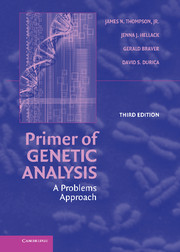Book contents
- Frontmatter
- Contents
- Preface
- Note on Genetic Symbols
- 1 Overview of Genetic Organization and Scale
- 2 Mitosis and Meiosis
- 3 Nucleic Acids: DNA and RNA
- 4 Basic Mendelian Genetics
- 5 Probability and Chi-Square
- 6 Sex-Linkage and Gene Interactions
- 7 Pedigree Analysis
- 8 Overview of Basic Statistical Testing
- 9 Quantitative Inheritance
- 10 Overview of Genetic Mapping
- 11 Assessing Chromosome Linkage Relationships
- 12 Linkage and Mapping in Diploids
- 13 Mapping in Bacteria and Viruses
- 14 Overview of Types of Genetic Change
- 15 Gene Mutation
- 16 Changes in Chromosome Number and Structure
- 17 Protein Synthesis and the Genetic Code
- 18 Gene Regulation and Development
- 19 Overview of Molecular Biology Techniques
- 20 DNA Mapping and Human Genome Analysis
- 21 Basic Population Genetics
- 22 Selection and Evolution
- 23 Practice Tests
- 24 Answers to Practice Tests and Crossword Puzzles
- 25 Landmarks in the History of Genetics
- Glossary
- Reference Tables
10 - Overview of Genetic Mapping
Published online by Cambridge University Press: 05 June 2012
- Frontmatter
- Contents
- Preface
- Note on Genetic Symbols
- 1 Overview of Genetic Organization and Scale
- 2 Mitosis and Meiosis
- 3 Nucleic Acids: DNA and RNA
- 4 Basic Mendelian Genetics
- 5 Probability and Chi-Square
- 6 Sex-Linkage and Gene Interactions
- 7 Pedigree Analysis
- 8 Overview of Basic Statistical Testing
- 9 Quantitative Inheritance
- 10 Overview of Genetic Mapping
- 11 Assessing Chromosome Linkage Relationships
- 12 Linkage and Mapping in Diploids
- 13 Mapping in Bacteria and Viruses
- 14 Overview of Types of Genetic Change
- 15 Gene Mutation
- 16 Changes in Chromosome Number and Structure
- 17 Protein Synthesis and the Genetic Code
- 18 Gene Regulation and Development
- 19 Overview of Molecular Biology Techniques
- 20 DNA Mapping and Human Genome Analysis
- 21 Basic Population Genetics
- 22 Selection and Evolution
- 23 Practice Tests
- 24 Answers to Practice Tests and Crossword Puzzles
- 25 Landmarks in the History of Genetics
- Glossary
- Reference Tables
Summary
Genetic mapping is the process of determining where a given gene is located in the genome. There are several different levels, or degrees of resolution, and a wide variety of techniques one can use. For example, one can map a gene to a major cell region, such as nuclear DNA versus mitochondrial or cytoplasmic DNA. Within the nucleus, a gene can be mapped to the X chromosome or to one of the autosomes. Within a chromosome, techniques like the frequency of recombination between pairs of heterozygous loci, the expression of recessive alleles in deletion heterozygotes, and biochemical markers detected in nuclei of somatic cell hybrids can give geneticists evidence about the linkage map order and relative spacing of genes.
A basic question behind genetic mapping is, What is a gene? A gene can be defined in molecular terms as a locus or DNA sequence on a chromosome. It can also be defined in terms of function through the phenotype it produces. Before mapping a gene, one generally has a phenotype to work with, but not the associated DNA sequence. That is what mapping is trying to identify. But there are pitfalls in working simply with phenotypes; one of the major ones is that different genetic loci acting on the same biochemical process can have the same phenotype. The fine structure mapping done by S. Benzer (1955) showed that recombination can occur both within and between genes and led to the concept of complementation.
- Type
- Chapter
- Information
- Primer of Genetic AnalysisA Problems Approach, pp. 97 - 103Publisher: Cambridge University PressPrint publication year: 2007



